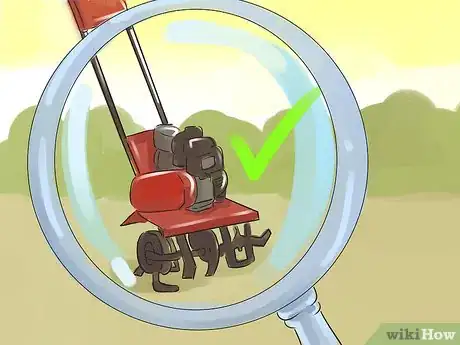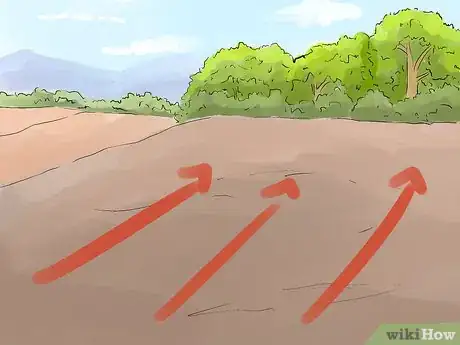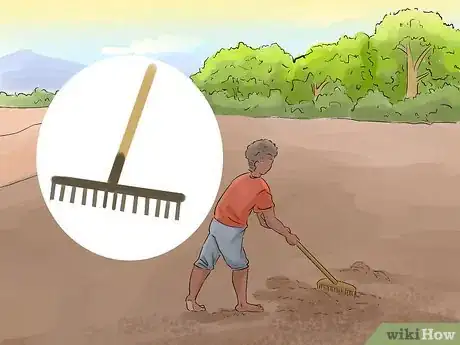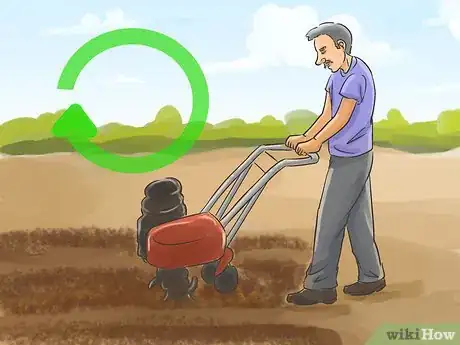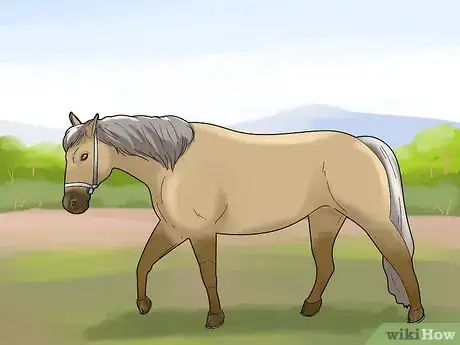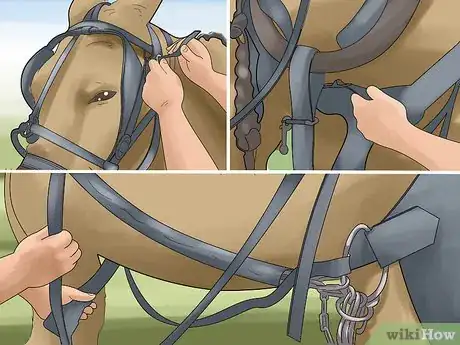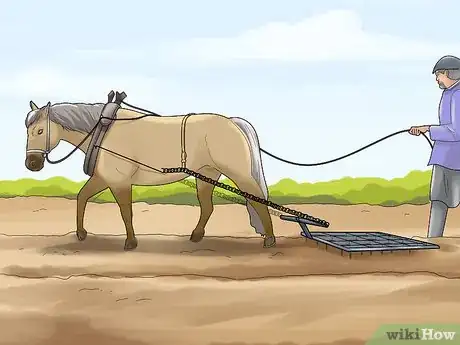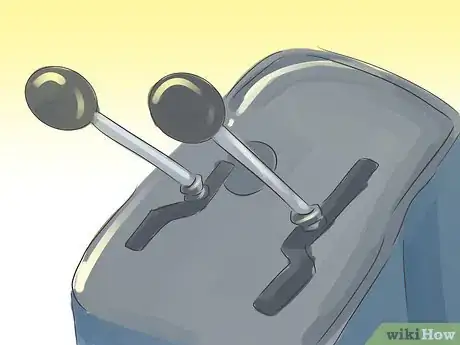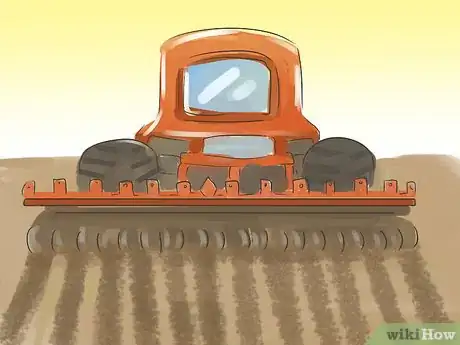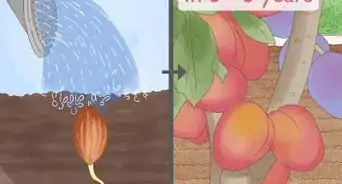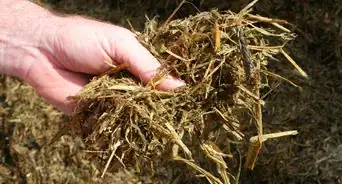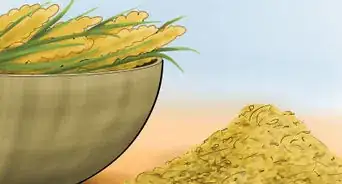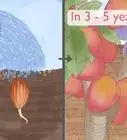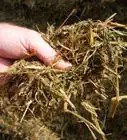wikiHow is a “wiki,” similar to Wikipedia, which means that many of our articles are co-written by multiple authors. To create this article, 10 people, some anonymous, worked to edit and improve it over time.
This article has been viewed 65,080 times.
Learn more...
Plowing (sometimes spelled "ploughing") is the process of turning over and loosening the top layer of soil. This makes it easier for seedling crops to take root and has the added benefit of removing crop residue and weeds. There are many different ways to plow. Depending on the equipment you have and the size of your field, you may need to use anything from a tractor-pulled plowing rig to a simple spade and rake.
Steps
Preparing to Plow
-
1Schedule your plowing just before planting. The purpose of plowing is to get the field ready for crops to be planted. For this reason, the best time to plow is generally right before you plan to plant your crops. Generally, this means the beginning of the growing season, which can vary based on your location.
- Technically, you can plow any time after the previous year's harvest and before the spring planting period. However, leaving too much time between plowing and planting can lead to soil erosion.
- A good guide showing the approximate start of various growing seasons in the continental U.S. is available here.
-
2Check your equipment. This is important if using a tractor or other mechanized plowing machine. Make sure all parts are in good working order following winter storage. Top off any fluids or lubricants and make sure the tires have adequate pressure.
- If plowing by hand or using animal plowing, make sure the blades are straight and that whoever/whatever is pulling the plow is healthy and strong.
Advertisement -
3Clear the field of obstructions. Take a walk through the field, looking for any obstacles (like rocks, pieces of wood, and loose foliage) that can be removed. Try to get the field as level as possible by filling in small holes or smoothing out raised patches. Take note of any obstacles that you cannot remove (like trees, boulders, etc.).
- Before plowing, mow the field so any vegetation is low to the ground. Too much vegetation can clog mechanical plows and make the work harder for manual plowing methods.
-
4Plan out the plow route. To make the best use of your time and effort, plan a route that's as efficient as possible. Know where you will need to stop and turn the plow. You'll also want to make sure you know where the edges of your field are so you don't plow into another person's field or into a field already plowed and planted. Finally, plan to plow around any obstacles that can't be removed.
- For rectangular fields, plow back and forth in long rows, turning when you reach either end. This minimizes the number of times you will need to turn around.
- However, if you're using animals on a field more than 150m long, plow in the direction of the short sides of the field, which gives the animals chance to rest.
- For non-rectangular fields, you can plow efficiently by following the contours of the field and working your way towards the center.
Plowing by Hand
This approach relies on your own strength and endurance. It is best for gardens and small plots of growing land up to about an acre.
-
1Use a spade to turn the soil up in rows. Starting in the corner of your plot or garden, plunge your spade a few inches into the ground. Turn the dirt oil, keeping most of the topsoil on top (the topsoil will be richer, softer, and darker than the soil underneath it). Repeat this process, proceeding down the edge of your plot, then doubling back when you reach the end. Leave turned-over rows (or furrows) a foot or two apart from each other.
- In most locations, the topsoil is about six inches to a foot thick (though this can vary).
-
2Rake the ground. Once you've tilled your plot into rows, go back over your work with a rake. Use the rake to break up large soil clods, loosening the soil so that it can accept seeds. You'll want this loose, broken-up soil to extend about two inches deep.
- For most crops, aim to break the soil into clumps smaller than the size of a dime.
-
3Leave furrows for good drainage. As you rake the soil, take care not to flatten your plot with your footsteps. A flat field will retain too much water in the event of rain, which can lead to crop failures. Try to preserve the highs and lows of your furrows so that excess water is directed to the edges of the field.
Plowing with a Machine Tiller
A rotary tiller is less labor-intensive than working by hand. It is best for smaller plots up to about five or six acres.[1]
-
1Pick an appropriate tiller for the job. Most modern tillers come in one of two varieties: "front-line" (driven by the front wheels) and "rear-line" (driven by the rear wheels). Both will work for gardens and small fields, but if you have the choice, pick the type that's most appropriate. See below:
- Front-line tillers are typically easier to use and better for smaller gardening situations. They handle like a power lawnmower and can be used in tighter spaces than a rear-line tiller.
- Rear-line tillers are better for bigger plowing jobs. They're bulkier and make wider turns, so use them away from plants and property you want to protect.
-
2Pick an appropriate tilling depth and speed. Almost all mechanical tillers allow you to adjust these settings with controls on the unit. As a general rule, harder, compacted soils require slower, shallower plowing. Tilling too deep or too fast in this soil can overwork the motor. For established beds, you can use deeper, faster tilling.
-
3Till in straight rows. Position the tiller in the corner of your field where you plan on starting. Start the tiller with the starting mechanism. This can vary from unit to unit but is often similar to the type of mechanism you might expect on a lawn mower. Use the tiller's controls to slowly work your way down the plot in a straight line, turning around and doubling back at the end.
- Some tillers have a safety switch that prevents starting. If you can't get the tiller started, check for one of these.
-
4Re-till if needed to break down the soil. Be prepared to go over your work a second time with the tiller. Any clods of dirt should be broken into roughly dime-sized pieces or smaller. When you're finished, your plot should be tilled into a series of loose furrows so that water can drain to the edges.
Plowing with an Animal Plow
This method requires at least one draft animal (like a horse, mule, etc.) strong enough to pull your plow. It's best for small and medium-sized fields up to about 150 meters per side. [2]
-
1Pick a draft animal that is broken to the plow. Several different animals are suitable for plowing. Among the most common are mules, horses, and oxen. Whichever animal you use should be broken to the plow — that is, it should be calm, comfortable and obedient with this sort of work. Working with an unbroken animal can be dangerous. Losing control while plowing can lead to injury for you or the animal.
-
2Harness your animal to the plow. The exact sort of harnessing necessary will vary by animal and by plow. Get an expert to help you if you are unsure how to proceed — harnessing the animal incorrectly can hurt it. Below are general instructions:[3]
- Catch the animal and bridle it. Place the metal bit in its mouth and secure the leather straps on either side.
- Harness the collar around the animal's neck. Connect the collar to the harness draped over the animal's back. Fasten the harness to the collar.
- Attach the trace chains from the harries, through the loops in the back band and belly band, and to the plow's singletree.
- Remember the belly band if you're using a horse—without this, horses can be choked by the weight of the plow if the harness slips.
-
3Start plowing in straight rows. Lead the animal to the corner of the field to be plowed. Have the animal walk forward as you plunge the blade of the plow into the ground to break up the earth. Walk between the handles behind the animal, controlling its speed so that it moves at a manageable pace. Use the plow's handles to control the angle and depth of the blade. Have the animal turn around when it reaches either end of the field and double back.
- As noted above, for extra-long fields, it's best to plow in the direction of the short sides to give your animal more breaks.
-
4If you can, switch out plow blades to get good furrows. There are a few different ways to get straight, properly-spaced furrows when you're working with an animal plow. Here is one versatile method that uses a type of plow called a "turning plow" as well as a different variety called a Georgia stock plow:
- First, use the turning plow to make two furrows with about 12 inches of unplowed space in between.
- Next, plow about 4 inches inside the balk (the unplowed space). Do the same on the other side, leaving about 4 inches of unplowed space in the middle.
- When your whole field is tilled this way, switch to a Georgia stock plow with a 20-inch sweep. Plow right through the middle of the balk.
- When you're finished, you'll have neat, orderly trenches you can drop your seeds into.
Plowing with a Tractor
This is the fastest, least labor-intensive option, though the equipment is expensive. This method is best for larger fields that can't be plowed with the methods above. See also: How to Plow With Two Row Cultivators
-
1Level the plowing rig. For best results, the plow pulled by the tractor must be level from side to side and from front to back. The more plow blades on the rig, the more important levelness is. Before you level the plow, move it to a concrete pad or another flat surface.
- There are normally levers for the two hydraulic arms. One lifts both arms up and down, and the other is for the plow draft, or side-to-side angle.
- Start by adjusting the plow draft until the plow is flat from one side to the other on the concrete (you can lay a carpenter's level on it to check).
- If there isn't a plow draft lever, there should at least be a manual crank on the one arm that you can turn to adjust the angle.
- Next, adjust the third upper arm so that the plow is level front to back. It may need further adjusting when you start plowing.
-
2Set the depth for your plow. When you're using a mechanical rig, you can use hydraulic controls to change the depth of the plows as you work. You want the plow blades deep enough that they turn over the top layer of soil. However, the plow shouldn't be so deep that it is causes the tractor to labor hard. The exact way to adjust the plow's depth will vary from rig to rig.
- There is normally a depth stop on the up and down lever for the plow's hydraulic arms. Set it so your plow stops at the proper depth each time you drop it.
- If the tractor starts pulling too hard, raise the plow up a little then let it back down while still moving forward.
- If the ground is wet and you start spinning your wheels, pull the plow up fast
-
3Plow in even rows. Position your tractor with the plowing rig hitched behind it in the corner of your field. Start plowing your field in rows, using the hydraulic controls to lower the plows into the dirt. When you reach the end of a row, raise the plows out of the ground as you turn, then lower them again for the next row.
- Space out your furrows carefully because these will be the low, wet spots in the field.
- After you plow each row, there will be a rut at the one side of where you just plowed. When you turn around, your inside tractor's tire should go into this rut.
- The next swipe should plow the dirt from the next row over into that rut, covering it up.
-
4Plow your end rows perpendicular to the rest. When you're using a tractor to plow a large field, you need to worry about soil erosion. One way to fight this is to plow the end rows (the rows along the shorter edges of the field) at 90 degrees to your main rows. This way, the raises and furrows act as a protective barrier from wind and rain, keeping the soil from washing away.
- If you're not dealing with a perfectly rectangular field, your end rows may not be perfectly 90 degrees. This is OK—just get the opposing edges of the field as straight as possible.
References
- ↑ http://grounds-mag.com/mag/grounds_maintenance_rotary_tillers/
- ↑ http://www.motherearthnews.com/homesteading-and-livestock/walking-plows-zmaz74zhol.aspx
- ↑ http://www.motherearthnews.com/homesteading-and-livestock/walking-plows-zmaz74zhol.aspx?PageId=5
- ↑ http://www.farmcollector.com/farm-life/miles-per-acre.aspx
About This Article
To plow a small field by hand, start just before the growing season by removing sticks and rocks from the field, and filling in any holes to make it more level. Then, use a spade to turn up the dirt in rows, so the darker, richer topsoil is on the surface and the rows are 1-2 feet apart. Once you’ve tilled the soil, go back over your plot with a rake to break up any large chunks that remain. Try to make sure any clumps you leave are smaller than a dime, so the seeds you plant can take root easily. To learn how to plow your field with a tractor or a machine tiller, keep reading!

